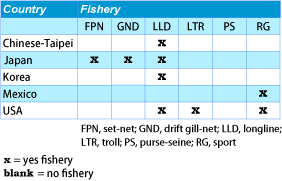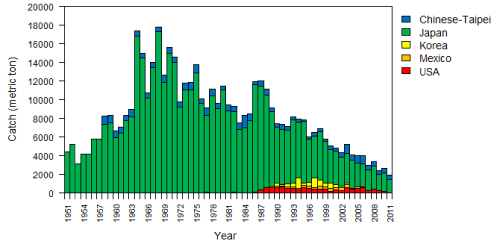- Home
- Working Groups
- Billfish
- Striped Marlin (Previous version)
Billfish Working Group
Striped Marlin (Kajikia audax) --- North Pacific
◊ Biological Profile
Striped marlin is distributed across about 85° of latitude in the Pacific Ocean. Its distribution is "horseshoe-shaped", with the greatest abundances occurring in the eastern and northern Central Pacific Ocean.
This species is epipelagic, highly migratory, and the most abundant and widely distributed of the istiophorid billfishes. The relative abundance of striped marlin tends to vary seasonally by locality, including the presence of mature females and larvae.
Striped marlin are apex predators. They feed non-selectively on many types of epipelagic fishes, squids, and other organisms. Like other istiophorids, striped marlin are endothermic with a brain heater organ associated with the superior rectus muscle that warms the brain and retina and promotes visual acuity.

- Life span : At least 11 years
- Maximum size: About 230 cm in eye-fork
length in the western and central Pacific Ocean - Maturity: About 50% at 4 years old
- Spawning season: April-August
◊ Fisheries for Striped Marlin in the North Pacific Ocean

The national annual catch totals from the USA, Chinese-Taipei, and South Korea are similar in magnitude at several hundred metric tons. The recreational catches in Costa Rica and Mexico are comparable to each other, but lower than the catches from the nations with longline fisheries.
Catches of WCNPO striped marlin have exhibited a long-term decline since the 1970s. Catches averaged roughly 8,100 metric ton (mt) per year during 1970-1979 and declined by roughly 50% to about 3,800 mt per year during 2000-2009.

in the North Pacific Ocean, 1951-2011.
◊ Stock Status and Conservation Information
![]() Click here to see the latest information.
Click here to see the latest information.